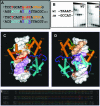Identification of the 'NORE' (N-Oct-3 responsive element), a novel structural motif and composite element
- PMID: 15767276
- PMCID: PMC1065252
- DOI: 10.1093/nar/gki284
Identification of the 'NORE' (N-Oct-3 responsive element), a novel structural motif and composite element
Abstract
N-Oct-3 is a neuronal transcription factor widely expressed in the developing mammalian central nervous system, and necessary to maintain neural cell differentiation. The key role of N-Oct-3 in the transcriptional regulation of a multiplicity of genes is primarily due to the structural plasticity of its so-called 'POU' (acronym of Pit, Oct, Unc) DNA-binding domain. We have recently reported about the unusual dual neuro-specific transcriptional regulation displayed by N-Oct-3 [Blaud,M., Vossen,C., Joseph,G., Alazard,R., Erard,M. and Nieto,L. (2004) J. Mol. Biol., 339, 1049-1058]. To elucidate the underlying molecular mechanisms, we have now made use of molecular modeling, DNA footprinting and electrophoretic mobility shift assay techniques. This combined approach has allowed us to uncover a novel mode of homodimerization adopted by the N-Oct-3 POU domain bound to the neuronal aromatic amino acids de-carboxylase and corticotropin-releasing hormone gene promoters and to demonstrate that this pattern is induced by a structural motif that we have termed 'NORE' (N-Oct-3 responsive element), comprising the 14 bp sequence element TNNRTAAATAATRN. In addition, we have been able to explain how the same structural motif can also induce the formation of a heterodimer in association with hepatocyte nuclear factor 3beta(/Forkhead box a2). Finally, we discuss the possible role of the NORE motif in relation to neuroendocrine lung tumor formation, and in particular the development of small cell lung cancer.
Figures





Similar articles
-
Winged helix hepatocyte nuclear factor 3 and POU-domain protein brn-2/N-oct-3 bind overlapping sites on the neuronal promoter of human aromatic L-amino acid decarboxylase gene.Brain Res Mol Brain Res. 1998 May;56(1-2):227-37. doi: 10.1016/s0169-328x(98)00048-5. Brain Res Mol Brain Res. 1998. PMID: 9602135
-
Characteristic patterns of N Oct-3 binding to a set of neuronal promoters.J Mol Biol. 2004 Jun 18;339(5):1049-58. doi: 10.1016/j.jmb.2004.04.035. J Mol Biol. 2004. PMID: 15178247
-
Atypical binding of the neuronal POU protein N-Oct3 to noncanonical DNA targets. Implications for heterodimerization with HNF-3 beta.Eur J Biochem. 2001 Feb;268(3):781-91. doi: 10.1046/j.1432-1327.2001.01934.x. Eur J Biochem. 2001. PMID: 11168419
-
The virtuoso of versatility: POU proteins that flex to fit.J Mol Biol. 2000 Oct 6;302(5):1023-39. doi: 10.1006/jmbi.2000.4107. J Mol Biol. 2000. PMID: 11183772 Review.
-
Differential activity by DNA-induced quarternary structures of POU transcription factors.Biochem Pharmacol. 2002 Sep;64(5-6):979-84. doi: 10.1016/s0006-2952(02)01164-4. Biochem Pharmacol. 2002. PMID: 12213595 Review.
Cited by
-
Fine-tuning of intrinsic N-Oct-3 POU domain allostery by regulatory DNA targets.Nucleic Acids Res. 2007;35(13):4420-32. doi: 10.1093/nar/gkm453. Epub 2007 Jun 18. Nucleic Acids Res. 2007. PMID: 17576670 Free PMC article.
-
5'UTR of the neurogenic bHLH Nex1/MATH-2/NeuroD6 gene is regulated by two distinct promoters through CRE and C/EBP binding sites.J Neurosci Res. 2007 Jan;85(1):1-18. doi: 10.1002/jnr.21093. J Neurosci Res. 2007. PMID: 17075921 Free PMC article.
-
Novel genotype-phenotype correlations, differential cerebellar allele-specific methylation, and a common origin of the (ATTTC)n insertion in spinocerebellar ataxia type 37.Hum Genet. 2024 Mar;143(3):211-232. doi: 10.1007/s00439-024-02644-7. Epub 2024 Feb 23. Hum Genet. 2024. PMID: 38396267 Free PMC article.
-
Directed Evolution of an Enhanced POU Reprogramming Factor for Cell Fate Engineering.Mol Biol Evol. 2021 Jun 25;38(7):2854-2868. doi: 10.1093/molbev/msab075. Mol Biol Evol. 2021. PMID: 33720298 Free PMC article.
-
Phosphorylation of BRN2 modulates its interaction with the Pax3 promoter to control melanocyte migration and proliferation.Mol Cell Biol. 2012 Apr;32(7):1237-47. doi: 10.1128/MCB.06257-11. Epub 2012 Jan 30. Mol Cell Biol. 2012. PMID: 22290434 Free PMC article.
References
-
- Warren A.J. Eukaryotic transcription factors. Curr. Opin. Struct. Biol. 2002;12:107–114. - PubMed
-
- Johnson W., Jameson J.L. Transcriptional control of gene expression. In: Jameson J.L., editor. Principles of Molecular Medicine. Towota, NJ: Humana Press Inc.; 1998.
-
- Latchman D.S. Transcription factors as potential targets for therapeutic drugs. Curr. Pharm. Biotechnol. 2000;1:57–61. - PubMed

